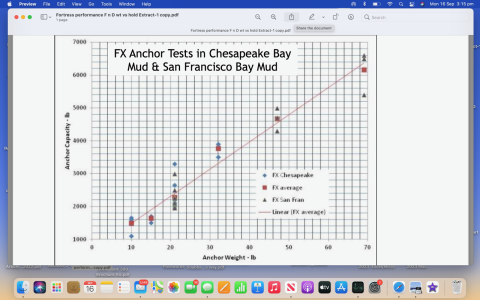Laminar Flow
Well-known member
I love these discussions that take place in a vacuum.
I do not care whether my anchor's holding power is 2000kg, 1000kg or 500 kg. All I care about, is that it holds me fast in the present conditions or the the ones I am expecting shortly, over the next night. Fortunately I can easily calculate my anchor's present holding power when setting it. If I deem it not sufficient, I relocate or try again.
The formula is: displacement x (velocity while backing in in m/s divided by the time in sec it takes from the time the boat begins to slow down until the rode comes stiff)
If my wife backs in at 2 kts, for that is the division of labour on our fine ship of 8500 kg, and it takes 15 sec for the chain to come tight and the boat to stop up (a fairly conservative assumption for the purpose of this example) , then I know the anchor will hold 566 kg, which is a couple of hundred kg more than the wind load in a F10.
If you are concerned about "dynamic" loads, they can be calculated in the same way.
When calculating windload, simply assume the the frontal profile as a flat rectangle and that the rig represents a rectangle of beam x 40% of rig height. This is accurate enough and, furthermore, allows for a sufficient (safety) margin for increased loads when the boat veers.
I do not care whether my anchor's holding power is 2000kg, 1000kg or 500 kg. All I care about, is that it holds me fast in the present conditions or the the ones I am expecting shortly, over the next night. Fortunately I can easily calculate my anchor's present holding power when setting it. If I deem it not sufficient, I relocate or try again.
The formula is: displacement x (velocity while backing in in m/s divided by the time in sec it takes from the time the boat begins to slow down until the rode comes stiff)
If my wife backs in at 2 kts, for that is the division of labour on our fine ship of 8500 kg, and it takes 15 sec for the chain to come tight and the boat to stop up (a fairly conservative assumption for the purpose of this example) , then I know the anchor will hold 566 kg, which is a couple of hundred kg more than the wind load in a F10.
If you are concerned about "dynamic" loads, they can be calculated in the same way.
When calculating windload, simply assume the the frontal profile as a flat rectangle and that the rig represents a rectangle of beam x 40% of rig height. This is accurate enough and, furthermore, allows for a sufficient (safety) margin for increased loads when the boat veers.

